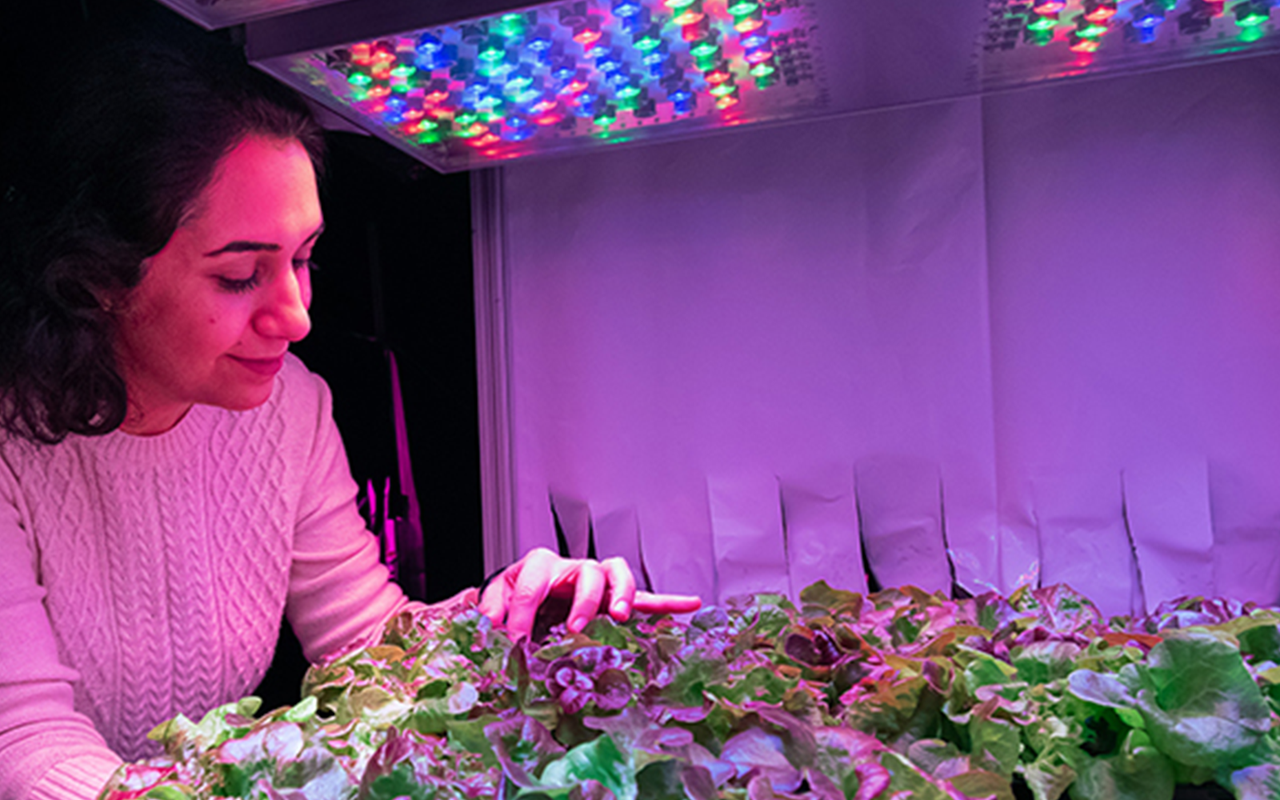New LED Strategies Could Make Vertical Farming More Productive, Less Costly
Purdue University researchers have designed two simple LED lighting strategies to increase yield and reduce energy costs for the vertical farming sector of indoor agriculture. The close-canopy and focused-lighting strategies developed by PhD candidate Fatemeh Sheibani and professor Cary Mitchell, both in the Department of Horticulture and Landscape Architecture in Purdue’s College of Agriculture, capitalize on LED lighting’s special properties.
“One is that they are relatively cool at the emitting surface, in contrast with other lighting choices,” Sheibani said. Thus, the lighting system works closer to plants without scorching them. LEDs are also current driven, unlike many energy-intensive, voltage-driven lighting sources.
Their work is part of a project called OptimIA (Optimizing Indoor Agriculture). The project, led by Michigan State University, includes collaborators at Purdue, University of Arizona and Ohio State University. OptimIA is sponsored by the U.S. Department of Agriculture's Specialty Crop Research Initiative.
In vertical agriculture, produce grows using LEDs as the sole lighting source (see YouTube video).
“It is the fastest-growing sector of controlled-environment ag,” Mitchell said. “There are new startups going on in urban and para-urban areas all the time, and worldwide.”
Fueled by an enthusiastic investment sector, the U.S. is a worldwide industry leader. But labor and energy costs, totaling about 60% of running an indoor farm, threaten the startups’ future. Inflation and rising energy costs have made an already fragile industry even more so. Startup costs are also high, both for land in urban areas and for LED lighting system installment.
But indoor farms can easily lower energy use while achieving their usual yield with the close-canopy-lighting strategy. Or, they can increase yield while maintaining their previous energy use. Indoor farmers can dim the voltage of a 1,000-watt, high-pressure sodium lamp with a rheostat, but that merely turns the energy into heat without any savings.
“It’s hidden energy,” Mitchell said. But with the LEDs, the current flow can be reduced, and light output is reduced proportionally.
Close-canopy lighting works because LEDs shine in all directions, like the sun. At standard plant/light separation distances, significant light streaming at wide angles over the plants misses them entirely. But with reduced separation distances, the plants absorb light that would otherwise go to waste.
Today, indoor farms can affordably offer only leafy greens and culinary herbs to consumers. Their quick growth allows for many cropping cycles year-round, unlike produce grown in gardens or fields.
And once they reach high-cost urban areas, indoor-produced salad kits and leafy greens might sell for $16 or $17 a pound.
“What they sell you in the store in a clamshell or as an individual plant is just a fraction of a pound,” Mitchell said.
LEDs are the lighting system of choice for indoor farming because of their relative energy efficiency and long lifetimes, Sheibani said. But improved LEDs also have high photon efficacy, meaning that electric energy is more readily converted to light that plants can use efficiently.
Still, inefficient capture of LED light reduces their benefits. Many indoor farmers, for instance, mistakenly believe that they can place their LEDs anywhere. But Sheibani and Mitchell noticed both in vertical farms and in smaller-scale experiments that the light fell not only on the plants but also on the walls and walkways. By reducing the distance between the LED system and the leaf canopy, the researchers were able to reduce such wasted light.
“We can improve canopy photon capture efficiency, as we call it, as long as we use LEDs correctly,” Sheibani said. “Canopy photon capture efficiency is the fraction of photons that reach the photosynthesizing machinery of the plants.”
Sheibani measures waste via a ratio of plant growth to LED electrical energy consumption. The resulting energy utilization efficiency compares grams of fresh or dry biomass yield per kilowatt hour of energy consumed by the LED lighting system.
“The higher the grams of fresh or dry biomass produced per kilowatt hour, the better it is,” she said. And both of Purdue’s tested scenarios found that the closest separation distance had the highest energy utilization efficiency.
Sheibani and Mitchell also are testing an energy-saving, focused-lighting approach that relies on a custom-made LED system with selective controls. How do small, individual, widely separated plants fare under slowly spreading beams of light rather than full coverage all the time?
“When seedlings emerge after germination, the very small plants are wide apart,” Mitchell said.
“It takes two weeks for them to grow together and close a canopy of baby greens. Everything in between is mostly wasted light until then.”
Sheibani and Mitchell’s system minimizes that waste. When plants are still small, they use full-coverage LED lighting inefficiently, Sheibani said. But it is possible to save energy in the earlier growth stages with focused lighting.
“Then when the plants are at the stage that they can use light efficiently, we can upgrade to provide the optimum amount,” she said.
OptimIA offers more information in free video presentations at OptimIAUniversity and the Indoor Ag Science Café.
“There’s a lot of excitement about indoor ag and people are jumping into it,” Mitchell said. “But they don’t really have the secret for long-term profitability yet. That’s where academic research such as the OptimIA project comes in to help.”
© 2023 Luger Research e.U. – Institute for Innovation & Technology

